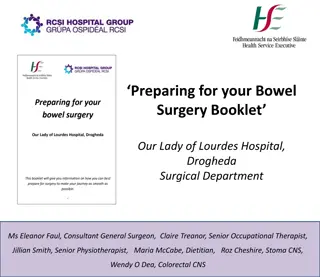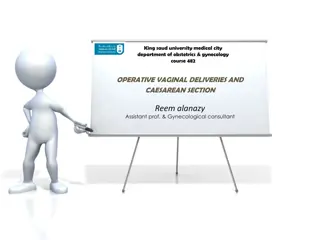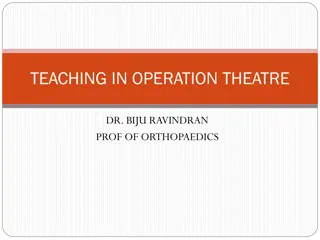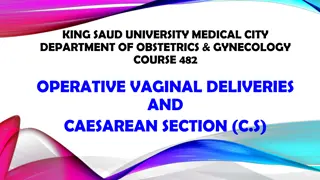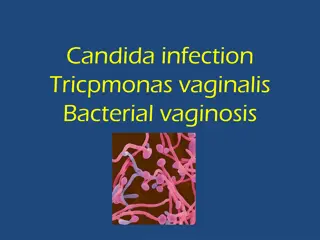Operative Vaginal Delivery: Insights and Techniques
Operative vaginal delivery, involving the use of forceps or vacuum devices, is a crucial intervention in obstetrics. This informative presentation covers definitions, types of forceps, success rates, and classifications of forceps deliveries. Explore the intricacies of outlet forceps, low forceps, and specialized forceps like Kielland and Piper. Enhance your understanding of instrumental deliveries—a vital aspect of modern obstetric care.
Download Presentation

Please find below an Image/Link to download the presentation.
The content on the website is provided AS IS for your information and personal use only. It may not be sold, licensed, or shared on other websites without obtaining consent from the author.If you encounter any issues during the download, it is possible that the publisher has removed the file from their server.
You are allowed to download the files provided on this website for personal or commercial use, subject to the condition that they are used lawfully. All files are the property of their respective owners.
The content on the website is provided AS IS for your information and personal use only. It may not be sold, licensed, or shared on other websites without obtaining consent from the author.
E N D
Presentation Transcript
Instrumental (Operative ) Vaginal Delivery 3/13/2025 1
Operative vaginal delivery Definitions- Delivery in which the operator uses forceps or vacuum device to assist the mother in transitioning the fetus to extrauterine life. It includes also Destructive deliveries, which are procedures undertaken to reduce the bulk of a dead fetus in obstructed labor to facilitate delivery. 3/13/2025 2
Introduction Incidence: - 6 % of all births. - vacuum done 4x than forceps. - success rate for operative vaginal deliveries, if properly conducted, is 99% 3/13/2025 3
FORCEPS Obstetric forceps is a pair of instruments designed to effect delivery of the fetus by applying traction to the fetal head. Types of forceps Classical Simpson Tucker-McLane Specialized Kielland Piper 3/13/2025 4
Classic forceps 3/13/2025 5
Simpson 3/13/2025 6
Tucker-McLane 3/13/2025 7
Kielland 3/13/2025 8
Piper 3/13/2025 9
Classification of forceps deliveries Outlet forceps: The scalp is visible at the introitus, without separating the labia. The fetal skull has reached the pelvic floor The sagittal suture is in anteroposterior diameter, or right/left occipito anterior, or occipito posterior position The fetal head is at or on the perineum Rotation does not exceed 45 !! 3/13/2025 10
Low forceps: The leading point of the fetal skull is 2 cm or more beyond the ischial spines (at least +2 cm station or below), but not on the pelvic floor; Low forceps have two subdivisions: a) rotation is 45 degrees or less (left or right occiput anterior to occiput anterior, or left or right occiput posterior to occiput posterior), & b) rotation more than 45 degrees. 3/13/2025 11
Mid forceps The station is above +2cm , but the head is engaged. High forceps This is not included in the classification Obsolete and dangerous 3/13/2025 12
Indications to use forceps 1.Prolonged second stage. 2.Suspicion of immediate or potential fetal compromise - e.g., NRFHR pattern, abruption) where expeditious vaginal delivery can be readily accomplished. 3.Shortening the second stage of labor for maternal benefit: - e.g., maternal cardiac disease, severe PE and Eclampsia, exhaustion. 3/13/2025 13
Prerequisites for forceps delivery The head must be engaged. The cervix must be fully dilated The position of the head must be known. The membranes must be ruptured. The fetus must be in a vertex or face mento anterior presentation (unless the purpose is to use forceps to assist in delivery of an after-coming head in breech presentation). 3/13/2025 14
Prerequisite ctd. The person in charge must be experienced in instrumental vaginal delivery. The option of performing an immediate caesarean delivery should be possible if complications arise No CPD. The patient must have adequate anesthesia/analgesia. . Bladder should be emptied 3/13/2025 15
Contraindications Any contraindication to vaginal delivery Refusal of the patient to consent to the procedure Cervix not fully dilated Inability to determine the presentation and fetal head position or pelvic adequacy Suspected CPD Unsuccessful trial of vacuum extraction Inadequate facilities and support staff 3/13/2025 16
Functions of forceps Traction (main job) Rotation (e.g. occipito transverse) Prevention (e.g. preterm fetus) 3/13/2025 17
Maternal complications Early (acute) complications include: lacerations to the cervix, vagina, perineum, or bladder extension of episiotomies, due to the added diameter of the presenting part. increase in blood loss intrapartum rupture of the unscarred uterus. 3/13/2025 18
Late complications mainly are related to injury to the pelvic support tissues and organs and include urinary stress incontinence fecal incontinence anal sphincter injuries pelvic organ prolapse 3/13/2025 19
Fetal complications Transient facial forceps marks, lacerations, and cephalhematomas . Skull fractures intracranial hemorrhage Cerebral palsy 3/13/2025 20
The Advantages of forceps they are unlikely to detach from the head can be sized to a premature cranium may be used for a rotation 3/13/2025 21
Failed Forceps A failed forceps is diagnosed if: Fetal head does not descend with each pull Fetus is undelivered after three pulls with no descent or after 30 minutes The possible causes are: Undiagnosed CPD Incomplete cervical dilatation Wrong diagnosis of position Incorrect application 3/13/2025 22
Vacuum Extractor (Ventous) The classic instrument consists of a disc shaped cup through which a vacuum of up to 0.8 kg/cm2 is applied to the fetal scalp 3/13/2025 23
VE Creates an artificial caput (chignon) through suction and application of metallic or plastic cup that holds firmly and allows adequate traction. In general, VE operations have similar indications as operations with forceps 3/13/2025 24
CHOICE OF INSTRUMENT Factors that might influence choice are The availability of the instrument The degree of maternal anaesthesia, and knowledge of the risks and benefits associated with each instrument Advantages of Vacuum devices are- easier to apply require less maternal anaesthesia Less trauma to the mother 3/13/2025 25
3/13/2025 26
Contraindications to vacuum extraction Operator inexperience Inability to achieve a proper application Uncertainty concerning fetal position/station Suspicion of feto-pelvic disproportion High fetal head Malposition (e.g, breech, face, brow) Known or suspected fetal coagulation defect Prior failed forceps Prematurity (fetuses <34 wk gestation) Prior scalp sampling 3/13/2025 27
Cups Metallic (rigid) v/s Plastic or silicon (soft) Metallic ones are mushroom shaped & soft cups are bell shaped. Rigid cups are for bigger fetuses, deep station, Molded head, OP position which requires more force. Soft cups for outlet vacuum or called lift out vacuum deliveries where minimal force is required. Soft cups are less traumatic than rigid ones. 3/13/2025 28
M shaped Bell shaped 3/13/2025 29
Mechanism of force generation Is by Chignon formation (artificial scalp edema) M shaped cups generate more force than bell shaped cups Cups have different sizes; 40mm, 50mm, 60mm, 70mm. As size increases force generated increases. 3/13/2025 30
TECHNIQUE Patient preparation - Bladder should be empty - The patient is placed in the dorsal lithotomy position and the fetal presentation, position, & station are confirmed and documented. 3/13/2025 31
Determine the flexion point - is the location on the fetal head where outward traction pulls the head so as to allow flexion at the neck. - In the normally molded fetal head FP is in the midline, over the sagittal suture, approximately 6 cm from the anterior fontanelle and 3 cm from the posterior fontanelle. 3/13/2025 32
- For a 60mm (6cm) cup, when the centre of the cup is placed over the FP, the edges of the cup should be approximately 3 cm from the anterior fontanelle and just at the edge of the posterior fontanelle. - The anterior fontanelle is the reference point for checking the application because access to the posterior fontanelle is partially blocked once the extractor cup is in place. 3/13/2025 33
Exert Traction: Traction is applied gradually as the contraction builds and is maintained for the duration of the contraction, In coordination with contraction & the mother's pushing. Perpendicular to the plane of the cup to maintain the seal with the fetal head. B/n contractions, check for fetal heart and cup application; 3/13/2025 34
Both hands are employed: - The fingertips of the dominant hand pull the device's crossbar, while the non-dominant hand monitors the progress of descent and prevents cup detachment by placing counter pressure with the thumb. With progress and absence of fetal distress, continue traction with contraction for 30 minutes or till three successive pulls fail to advance the head; As soon as the head is delivered, release the vacuum and proceed with the delivery of the fetus; 3/13/2025 35
Direction of pull: Traction is applied along the axis of the pelvic curve to guide the fetal vertex, led by the flexion point, through the birth canal. Initially is downward (toward the floor ,then extended upwards to a 45 degree angle to the floor as the head emerges from the pelvis and crowns. Traction is gradually discontinued as the contraction ends or the mother stops pushing. 3/13/2025 36
Duration of Application A maximum of two to three cup detachments, Three sets of pulls and/or A maximum total vacuum application time of 15 to 30 minutes. 3/13/2025 37
Function of vacuum Only traction is its function. Manual rotation to the cup should be avoided as it may cause cephalohematomas 3/13/2025 38
Failed Vacuum Diagnosis is based on any one of the following conditions The head doesn t advance with each pull; The fetus is not delivered with 3 pulls; The fetus is not delivered within 30 minutes; The cup that is applied appropriately & pulled in the proper direction with maximum negative pressures slips off the head twice 3/13/2025 39
3/13/2025 40
3/13/2025 41
Complications Neonatal injury: Subgaleal/subaponeurotic hemorrhage Scalp bruising/lacerations Long-term neonatal outcomes Maternal injury Lacerations 3/13/2025 42
Thanxx!!! 3/13/2025 43






